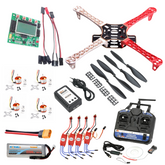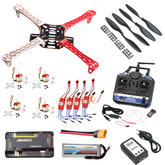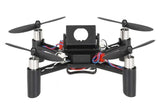How to build a quadcopter drone at home
Summary
Discover the exciting world of quadcopter drones with our comprehensive blog on building your own! Learn what a quadcopter drone is and explore the benefits of crafting one yourself. Unveil the secrets to selecting the right frame, motors, propellers, flight controller, radio transmitter, and battery to suit your needs. Follow our step-by-step instructions on assembling the components and configuring the flight controller. Embark on a thrilling journey as you test and finally fly your masterpiece. Unleash your creativity and passion for technology with this engaging and informative guide. Build your dream drone now!
What is a Quadcopter Drone?

A quadcopter drone is an unmanned aerial vehicle (UAV) powered by four rotors, arranged in a symmetrical X or + shape. These drones are also commonly known as quadrotors or quads. They are versatile and can be used for various purposes, including recreational flying, aerial photography, surveillance, and commercial applications.
Benefits of Building Your Own Drone
Building your own quadcopter drone offers numerous advantages. Firstly, it provides a deeper understanding of the drone's components and functionality, allowing you to customize and optimize its performance. Secondly, DIY drones are often more cost-effective than pre-built options, as you can select components that match your budget and preferences. Additionally, the process of building a drone can be a rewarding and educational experience, especially for enthusiasts and hobbyists.
read more : Assembling the DM002 Drone
Prerequisites and Skills Required
While building a quadcopter drone is an exciting endeavour, it does require some prerequisites and skills. Basic knowledge of electronics, soldering, and reading schematics will be beneficial. Familiarity with programming is also essential for configuring the flight controller. Moreover, patience, attention to detail, and a willingness to learn and troubleshoot are valuable traits for successful drone construction.
Overview of the Building Process
The process of drone building, crafting your own quadcopter, can be divided into several key steps. These include selecting the right frame, choosing suitable motors and propellers, picking the appropriate flight controller, selecting a compatible radio transmitter and receiver, choosing the right battery and power distribution system, assembling the components, configuring the flight controller, testing the drone, and finally, enjoying the thrill of flying your creation.
read more : Working of A Drone
Choosing the Right Frame

Understanding the Importance of the Frame
The frame of a quadcopter drone serves as its structural foundation, providing support and stability to the entire system. It also determines the drone's size, weight, and payload capacity. Selecting the right frame is crucial as it impacts the overall performance and flight characteristics of the drone.
Different Types of Frames Available
Quadcopter drone frames come in various materials, with carbon fiber, aluminum, and plastic being common options. Carbon fiber frames are lightweight, strong, and offer excellent vibration dampening, making them suitable for high-performance drones. Aluminum frames provide durability and rigidity, ideal for heavy-lifting drones. Plastic frames, on the other hand, are affordable and lightweight, suitable for beginners and casual fliers.
Factors to Consider When Selecting a Frame
When choosing a frame, consider factors such as the size and weight capacity of the frame, compatibility with other components, and the intended purpose of the drone. The frame's dimensions should accommodate the selected motors, propellers, flight controller, and battery, ensuring a proper fit and balance of the overall system.
read more : What are drones? A-Z Guide Of Assembly to Flying
Selecting Motors and Propellers

The Role of Motors and Propellers in Drone Flight
Motors and propellers play a crucial role in the flight of a quadcopter drone. The motors provide the necessary thrust to lift the drone off the ground, and the propellers convert this rotational motion into thrust for vertical ascent and descent. Proper selection of motors and propellers is essential for stable flight and efficient power usage.
How Many Motors and Propellers are Needed?
Quadcopter drones, as the name suggests, require four motors and propellers. Each motor is responsible for driving a single propeller, and the rotation of these propellers creates the lift and stability needed for flight.
Matching Motor and Propeller Sizes
The size of the motors and propellers should match the frame and weight of the drone. Larger drones may require more powerful motors and larger propellers to generate sufficient lift, while smaller drones can use smaller motors and propellers to achieve the desired performance.
read more : Drone Part List
Understanding Motor Specifications
When selecting motors, consider specifications such as motor size (measured in millimeters), kV rating (revolutions per volt), and maximum thrust output. Higher kV motors offer higher rotational speeds but may draw more current, affecting battery life.
Factors to Consider When Choosing Motors and Propellers
Factors to consider include the thrust-to-weight ratio, motor efficiency, and propeller pitch and diameter. A balance between these factors is essential to achieve optimal flight performance and efficiency.
Thrust-to-Weight Ratio
The thrust-to-weight ratio should be sufficient to lift the drone and carry any additional payload. A higher ratio indicates better lifting capability.
Motor Efficiency
Efficient motors translate electrical power into mechanical output with minimal losses, resulting in longer flight times and better overall performance.
read more : Drone Motor – Where to Begin?
Propeller Pitch and Diameter
The pitch and diameter of the propellers affect the drone's acceleration, top speed, and stability. Properly matched propellers ensure balanced flight characteristics.
Choosing the Right Flight Controller

Understanding the Flight Controller's Function
The flight controller is the brain of the quadcopter drone, responsible for interpreting pilot inputs and sensor data to maintain stability and control during flight. It utilizes various sensors, such as gyroscopes and accelerometers, to measure the drone's orientation and make adjustments as needed.
Types of Flight Controllers Available
Several flight controller options are available in the market, each with its unique features and capabilities. Common options include DJI NAZA M V2 FLIGHT CONTROLLER, KK 2.1.5 MULTI-ROTOR LCD FLIGHT CONTROL BOARD, PIXHAWK 2.4.8 DRONE FLIGHT CONTROLLER, APM 2.8 FLIGHT CONTROLLER, OPENPILOT CC3D FLIGHT CONTROLLER and APM 2.6 FLIGHT CONTROLLER BOARD
DJI NAZA M V2 FLIGHT CONTROLLER
The DJI Naza M V2 Flight Controller with GPS & PMU V2 is a popular choice for enthusiasts and professionals alike. It offers stable flight performance and comes with a built-in GPS module for precise positioning and advanced flight modes. The PMU V2 ensures reliable power distribution to all components.
KK 2.1.5 MULTI-ROTOR LCD FLIGHT CONTROL BOARD
The KK Board 2.1.5 Multi-Rotor LCD Flight Control Board is a budget-friendly option suitable for beginners and DIY drone builders. It features a simple setup process and provides stable flight control for quadcopters and other multi-rotor platforms.
PIXHAWK 2.4.8 DRONE FLIGHT CONTROLLER
The Pixhawk 2.4.8 Drone Flight Controller with PX4 32 Bit Autopilot is a high-performance controller designed for advanced users and professional drone applications. It supports various flight modes, autonomous mission planning, and reliable redundancy for increased safety.
APM 2.8 FLIGHT CONTROLLER
The APM 2.8 Flight Controller (without compass) is a well-established option known for its open-source ecosystem and extensive community support. It offers a wide range of features, including waypoint navigation and telemetry data transmission.
OPENPILOT CC3D FLIGHT CONTROLLER
The OpenPilot CC3D Flight Controller is a compact and lightweight option ideal for small to medium-sized quadcopters. It provides stable flight performance and offers a user-friendly setup process through the OpenPilot Ground Control Station.
APM 2.6 FLIGHT CONTROLLER BOARD
The APM 2.6 Flight Controller Board is another reliable choice from the APM series. It is suitable for various multi-rotor configurations and offers flexible customization options to tailor the drone's behavior to specific flying styles.
Selecting the right flight controller depends on your skill level, drone configuration, and desired features. Consider the specifications and capabilities of each product to make an informed decision that aligns with your drone building and flying goals.
read more : Upgrade Your Control: Best Drone Remote Controllers
Selecting a Radio Transmitter and Receiver

The Role of the Radio Transmitter and Receiver
The radio transmitter and receiver are essential components for controlling the quadcopter drone remotely. The transmitter is the handheld controller used by the pilot to send commands to the drone, while the receiver is installed on the drone and receives these commands, relaying them to the flight controller.
Understanding Radio Frequency and Channels
Radio transmitters and receivers operate on specific radio frequencies and channels. Common frequencies used in drone operation include 2.4 GHz and 5.8 GHz. Channels allow multiple drones to operate simultaneously without interference.
Hurry! Special price drop on 2.4 GHz 6 channel FlySky FS-i6 Transmitter.
Types of Transmitters and Receivers
There are various types of radio transmitters and receivers available, each with its unique features and capabilities.
Handheld Transmitters
Handheld transmitters come in various designs and offer different levels of functionality. Some transmitters have integrated LCD screens for telemetry data, while others may have programmable switches for custom flight modes.
Receiver Types
Receivers can be categorized based on the number of channels they support. Choose a receiver with sufficient channels to accommodate your desired flight controls and additional features.
Factors to Consider When Choosing a Transmitter and Receiver
When selecting a transmitter and receiver, consider factors such as compatibility with the flight controller and the drone's specific communication protocols. It is essential that the transmitter and receiver communicate seamlessly with the flight controller to ensure precise and reliable control.
Compatibility with the Flight Controller
Verify that the selected transmitter and receiver are compatible with the flight controller's communication protocols, such as PWM, PPM, or SBUS.
Range and Signal Quality
For reliable and smooth control, choose a transmitter and receiver with a sufficient range to cover the distances you intend to fly. Opt for systems with robust signal quality to minimize signal loss and interference.
Choosing the Right Battery

The Importance of Battery
The battery is crucial for providing the necessary electrical energy to power the drone's motors and electronics during flight. Selecting the right battery is vital for achieving optimal flight times and performance.
LiPo (Lithium Polymer) Batteries
LiPo batteries are lightweight and capable of delivering high currents, making them suitable for high-performance drones. However, they require careful handling and charging to avoid damage.
Factors to Consider When Selecting a Battery
When choosing a battery, consider factors such as its capacity (measured in milliampere-hours, mAh), voltage, and discharge rate. The battery capacity determines how long the drone can fly on a single charge, while the voltage must match the drone's electrical requirements.
Battery Capacity and Voltage
Higher battery capacity allows for longer flight times, but it also increases the overall weight of the drone. Choose a battery capacity that strikes a balance between flight time and weight.
Flight Time and Weight
Ensure that the selected battery provides sufficient flight time while keeping the drone's weight within acceptable limits for optimal performance.
read more : Affordable Drone Batteries
Assembling the Components
Step-by-Step Assembly Process
Assembling the components in the drone building process is a crucial step that demands precision and attention to detail. To ensure a successful build, follow these step-by-step instructions:
Attaching Motors and Propellers
Begin by carefully attaching each motor to its designated position on the drone's frame using the provided screws. Align the motor's direction to correspond with the appropriate propeller rotation. Securely fasten the propellers to the motor shafts, ensuring they are tightened properly and spin freely without any obstructions.
Installing the Flight Controller
Next, install the chosen flight controller onto the designated mounting location on the frame. To minimize vibrations and ensure accurate sensor readings, consider using vibration-damping materials. Ensure that the flight controller is securely affixed to the frame to prevent any movement during flight.
Connecting Motors and Receiver
Properly connect each motor to its corresponding output on the flight controller. Take care to follow the correct wiring configuration to avoid any confusion during operation. Similarly, connect the receiver to the flight controller, adhering to the appropriate communication protocols and ensuring a secure and reliable link.
Mounting the Battery
Carefully position the battery onto the drone's frame, ensuring it is adequately secured to prevent any dislodging during flight. Double-checking that all connections are tight and correctly polarized. An incorrect connection could lead to malfunctioning components or even irreversible damage.
Following these steps diligently will result in a well-assembled quadcopter drone ready for configuration and flight testing. Remember to exercise patience and attention to detail throughout the assembly process to achieve optimal performance and safety during your drone's operation.
Configuring the Flight Controller
Overview of Flight Controller Configuration
Configuring the flight controller during drone building involves programming it to respond to pilot inputs and maintain stable flight. The configuration process varies depending on the flight controller model, so refer to the manufacturer's guidelines and online resources for specific instructions.
Installing the Necessary Software
Most flight controllers require software for configuration. Download and install the appropriate software onto your computer to interface with the flight controller.
Calibrating Sensors and Motors
Calibrate the flight controller's sensors and motors to ensure accurate readings and precise control. This process typically involves adjusting gyroscopes, accelerometers, and motor outputs.
Setting Up Flight Modes and Failsafes
Configure flight modes to tailor the drone's behavior according to your flying preferences. Set up failsafes to trigger specific actions if signal loss or other critical events occur during flight.
Tips for Successful Configuration
For successful configuration, double-check all settings and consult online forums or community groups for advice and troubleshooting. Calibration and fine-tuning are crucial for optimal drone performance.
Testing and Flying Your Drone
Pre-flight Safety Checks
Before taking your drone for its maiden flight, conduct thorough pre-flight safety checks. Verify that all components are securely attached, and the battery is fully charged. Check for any loose connections or damaged parts.
Testing Motor Spin Direction
Power up the drone and verify that each motor spins in the correct direction. Motors on opposite diagonals should rotate in the same direction, while those on adjacent corners should rotate in opposite directions.
Performing a Hover Test
Perform a hover test in a controlled and open area to check the drone's stability and response to control inputs. Ensure that the drone hovers steadily without drifting or tilting excessively.
First Flight Tips and Tricks
For your first flight, start with gentle and slow movements to get accustomed to the drone's controls. Gradually increase the complexity of maneuvers as you gain confidence and experience.
Troubleshooting Common Issues
If you encounter any issues during testing or flight, refer to your flight controller's user manual and online resources for troubleshooting guidance. Common issues may include unstable flight, drifting, or unresponsive controls.
Conclusion
Building your own quadcopter drone is an exciting and rewarding journey that offers valuable insights into electronics and aerodynamics. By following the steps outlined in this guide, you can create a personalized drone that meets your specific needs and preferences.
The process of building and flying your own drone is a satisfying experience that fosters a deeper connection with the technology. Embrace the opportunity to explore new possibilities and unleash your creativity as a drone maker.
If you appreciate our work don't forget to share this post and leave your opinion in the comment box.
Please do check out other blog posts about Popular Electronics
Make sure you check out our wide range of products and collections (we offer some exciting deals!)








